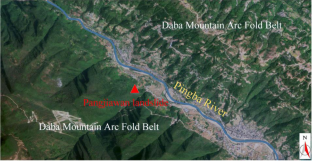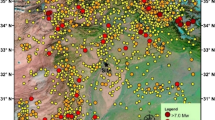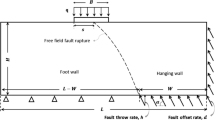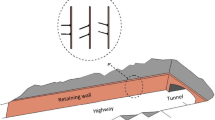Abstract
Landslide movement processes often exhibit complex paths, introducing the uncertainty of landslide movement paths, and challenging landslide hazard prediction and pre-disaster prevention and control. In this study, we employed numerical simulations to investigate the dynamic processes with complex paths of the Pangjiawan landslide using the 3D discrete element method. A scenario simulation was conducted to evaluate the stability of the landslide, incorporating arched anti-slide piles, and the reinforcing effect of arch anti-slide piles on the Pangjiayan landslide under different rise-span ratios and pile spacing was analyzed in depth. The results indicate that the Pangjiawan landslide in mountainous notch topography exhibits a complex movement path with turning and convergence behaviors, and arched anti-slide piles are more effective in stabilizing the landslide than traditional linear anti-slide piles. When the embedded depth of the arched anti-slide piles remains consistent, higher rise-span ratios result in more significant synergistic effects between the piles and the surrounding soil. Moreover, even with increased pile spacing and a reduction in the number of anti-slide piles, the landslide displacement after reinforcement with arched anti-slide piles is lower than traditional linear anti-slide piles. The research provides valuable insights into the dynamics of landslide movements, emphasizing the superior reinforcement capabilities of arched anti-slide piles. This contributes to our understanding of landslide mitigation strategies in challenging topography.





















Similar content being viewed by others
Data availability
The data used to support the findings of this study are available from the corresponding author upon request.
References
Bessette-Kirton EK, Coe JA, Schulz WH, Cerovski-Darriau C, Einbund MM (2020) Mobility characteristics of debris slides and flows triggered by Hurricane Maria in Puerto Rico. Landslides 17(12):2795–2809
Chen KT, Wu JH (2018) Simulating the failure process of the Xinmo landslide using discontinuous deformation analysis. Eng Geol 239:269–281
Cruz FD, Emam S, Prochnow M, Roux JN, Chevoir F (2005) Rheophysics of dense granular materials: discrete simulation of plane shear flows. Phys Rev E Stat Nonlinear Soft Matter Phys 72:021309
Cundall P, Strack O (1979) A discrete numerical model for granular assemblies. Geotechnique 29:47–65
Evans SG, Hungr O, Clague JJ (2001) Dynamics of the 1984 rock avalanche and associated distal debris flow on Mount Cayley, British Columbia, Canada; implications for landslide hazard assessment on dissected volcanoes. Eng Geol 61:29–51
Fan X, Dufresne A, Whiteley J, Yunus AP, Subramanian SS, Okeke CAU, Pánek T, Hermanns RL, Ming P, Strom A, Havenith HB, Dunning S, Wang G, Tacconi Stefanelli C (2021) Recent technological and methodological advances for the investigation of landslide dams. Earth Sci Rev 218:103646
Froude MJ, Petley D (2018) Global fatal landslide occurrence from 2004 to 2016. Nat Hazards Earth Syst Sci 18:2161–2181
Gao Y, Yin Y, Li B, Feng Z, Wang W, Zhang N, Xing A (2017) Characteristics and numerical runout modeling of the heavy rainfall-induced catastrophic landslide–debris flow at Sanxicun, Dujiangyan, China, following the Wenchuan Ms 8.0 earthquake. Landslides 14(4):1361–1374
Gianvito S, Xuanmei F, Qiang X, Chun L, Chaojun O, Guillem D, Fan Y, Lanxin D (2018) Some considerations on the use of numerical methods to simulate past landslides and possible new failures: the case of the recent Xinmo landslide (Sichuan, China). Landslides 15(7):1359–1375
Gilabert FA, Roux JN, Castellanos A (2007) Computer simulation of model cohesive powders: influence of assembling procedure and contact laws on low consolidation states. Phys Rev 75(1):011303
Gilabert FA, Roux JN, Castellanos A (2008) Computer simulation of model cohesive powders: plastic consolidation, structural changes, and elasticity under isotropic loads. Phys Rev 78(3):031305
Gu DM, Liu HL, Huang D, Zhang WG, Gao XC (2020) Development of a modeling method and parametric study of seepage-induced erosion in clayey gravel. Int J Geomech 20(12):04020219
Hu XD, Zhang L, Hu KH, Cui L, Wang L, Xia ZY, Huang QZ (2022) Modelling the evolution of propagation and runout from a gravel–silty clay landslide to a debris flow in Shaziba, southwestern Hubei Province. China Landslides 19(9):2199–2212
Hu XL, Tan FL, Tang HM, Zhang GC, Su AJ, Xu C, Zhang YM, Xiong CR (2017) In-situ monitoring platform and preliminary analysis of monitoring data of Majiagou landslide with stabilizing piles. Eng Geol 228:323–336
Huang D, Li YQ, Song YX, Xu Q, Pei XJ (2019) Insights into the catastrophic Xinmo rock avalanche in Maoxian county, China: combined effects of historical earthquakes and landslide amplification. Eng Geol 258:105158
Kim C, Kwon J, Im JC, Hwang S (2012) A method for analyzing the self-supported earth-retaining structure using stabilizing piles. Mar Georesour Geotechnol 30:313–332
Kumar VS, Chandrasekaran SS (2022) Analysis of failure of high slope subjected to rainfall infiltration at Peringavu in Kerala. India Eng Fail Anal 138:106423
Li LP, Lan HX (2021) Complexities of landslide moving path: a review and perspective. Earth Sci 47(12):4663–4680 (in Chinese)
Li L, Lan H, Strom A (2020) Automatic generation of landslide profile for complementing landslide inventory. Geomat Nat Haz Risk 11:1000–1030
Li B, Gong W, Tang H, Zou Z, Bowa VM, Juang CH (2021) Probabilistic analysis of a discrete element modelling of the runout behavior of the Jiweishan landslide. Int J Numer Anal Method Geomech 45(8):1120–1138
Li XS, Fan W, Cao YB, Quan ZL (2022) MatDEM-based numerical simulation analysis of yanjiagou landslide evolution process. Geol Resour 30(2):199–206 (in Chinese)
Lin CH, Lin ML (2015) Evolution of the large landslide induced by Typhoon Morakot: a case study in the Butangbunasi River, southern Taiwan using the discrete element method. Eng Geol 197:172–187
Lo CM, Lin ML, Tang CL, Hu JC (2011) A kinematic model of the Hsiaolin landslide calibrated to the morphology of the landslide deposit. Eng Geol 123:22–39
Lu CY, Tang CL, Chan YC, Hu JC, Chi CC (2014) Forecasting landslide hazard by the 3D discrete element method: a case study of the unstable slope in the Lushan hot spring district, central Taiwan. Eng Geol 183:14–30
Meng HY, Zhan JW, Lu QZ, Yu ZY, Kang JL, Sun YM (2022) Kinematics characteristics and numerical simulation analysis of “8.12” giant landslide in Shanyang county, Shaanxi province. J Eng Geol. https://doi.org/10.13544/j.cnki.jeg.2021-0645. (in Chinese)
O’Sullivan C (2011) Particulate discrete element modelling: a geomechanics perspective. Spon Press, Oxon
Pan H, Yang XS, Wu SM (2001) Calculation of internal force and deformation of arch retaining structure. J Build Struct 22(5):93–96 (in Chinese)
Potyondy D, Cundall P (2004) A bonded-particle model for rock. Int J Rock Mech Min Sci 41:1329–1364
Radjai F (2009) Force and fabric states in granular media, Aip Conference
Ray A, Verma H, Bharati AK, Rai R, Koner R, Singh TN (2022) Numerical modelling of rheological properties of landslide debris. Nat Hazards 110(3):2303–2327
Schaefer LN, Santi PM, Duron TC (2021) Debris flow behavior during the September 2013 rainstorm event in the Colorado Front Range, USA. Landslides 18(5):1585–1595
Shi C, De LI, Chen KH, Zhou JW (2016) Failure mechanism and stability analysis of the Zhenggang landslide in Yunnan Province of China using 3D particle flow code simulation. J Mt Sci 13(5):891–905
Shi C, Li W, Meng Q (2021) A dynamic strain-rate-dependent contact model and its application in hongshiyan landslide. Geofluids 2021:9993693
Tian XX, Song ZP, Zhang YW (2021) Monitoring and reinforcement of landslide induced by tunnel excavation: a case study from Xiamaixi tunnel. Tunn Undergr Space Technol 110:103796
Usluogullari OF, Temugan A, Duman ES (2016) Comparison of slope stabilization methods by three-dimensional finite element analysis. Nat Hazards 81(2):1027–1050
Wang HL, Liu SQ, Xu WY, Yan L, Xie WC (2020) Numerical investigation on the sliding process and deposit feature of an earthquake-induced landslide: a case study. Landslides 17(11):2671–2682
Wei JB, Zhao Z, Xu C, Wen Q (2019) Numerical investigation of landslide kinetics for the recent Mabian landslide (Sichuan, China). Landslides 16(11):2287–2298
Wu LL, He KQ, Guo L, Zhang J, Sun LN, Jia YY (2022) Research on the excavation stability evaluation method of Chaqishan ancient landslide in China. Eng Fail Anal 141:106664
Wu JH, Lin WK, Hu HT (2017) Assessing the impacts of a large slope failure using 3DEC: the Chiu-fen-erh-shan residual slope. Comput Geotech 88:32–45
Wu JH, Lin WK, Hu HT (2018) Post-failure simulations of a large slope failure using 3DEC: the Hsien-du-shan slope. Eng Geol 242:92–107
Xie Q, Cao ZL, Shi XK, Fu X, Ban YX, Wu ZH (2021a) Model test of interaction between load-caused landslide and double-row anti-slide piles by transparent soil material. Arab J Sci Eng 46:4841–4856
Xie Q, Cao ZL, Xie WB, Song ZP, Wu ZH (2021b) Model test and numerical analysis of cutting slope with skip cut method. Nat Hazard Rev 22(2):04021002
Xu JZ (2012) Research on new anti-slip structures and their engineering applications. Xinan Jiaotong University, Chengdu, China (in Chinese)
Xu LF, Meng XW, Xu XG (2014) Natural hazard chain research in China: a review. Nat Hazards 70(2):1631–1659
Yin Y, Xing A, Wang G, Feng Z, Jiang Y (2016) Experimental and numerical investigations of a catastrophic long-runout landslide in Zhenxiong, Yunnan, southwestern China. Landslides 14(2):649–659
Yin ZY, Wang P, Zhang F (2020) Effect of particle shape on the progressive failure of shield tunnel face in granular soils by coupled FDM-DEM method. Tunn Undergr Space Technol 100:103394
Zhang HX, Lu KP, Zhang WZ, Li DL, Yang GL (2022a) Quantification and acoustic emission characteristics of sandstone damage evolution under dry-wet cycles. J Build Eng 48:103996
Zhang JA, Kuang MX, Zhang YH, Feng TG (2022b) Evaluation and analysis of the causes of a landslide and treatment measures during the excavation of a tunnel through a soil-rock interface. Eng Fail Anal 130:105784
Zhang S, Li C, Qi H, Chen X, Ma S (2021) Soil arch evolution characteristics and parametric analysis of slope anchored anti-slide pile. KSCE J Civ Eng 25:4121–4132
Zhang ZW, Deng RG (2013) Theoretical study of spatial anti-slide structure of arc interval row piles with coupling beam on pile top. Rock Soil Mech 34(12):3403–3409 (in Chinese)
Zhao B, Wang YS, Wang Y, Shen T, Zhai YC (2017) Retaining mechanism and structural characteristics of h type anti-slide pile (hTP pile) and experience with its engineering application. Eng Geol 222:29–37
Zhou JW, Huang KX, Shi C, Hao MH, Guo CX (2015) Discrete element modeling of the mass movement and loose material supplying the gully process of a debris avalanche in the Bayi Gully, Southwest China. J Asian Earth Sci 99:95–111
Zhu BB, Lei MF, Gong CJ, Zhao CY, Zhang YL, Huang J, Jia CJ, Shi CH (2022) Tunnelling-induced landslides: trigging mechanism, field observations and mitigation measures. Eng Fail Anal 138:106387
Zhuang JQ, Jia KC, Zhan JW, Zhu Y, Zhang CL, Kong JX, Du CH, Wang SB, Cao YB, Peng JB (2022) Scenario simulation of the geohazard dynamic process of large-scale landslides: a case study of the Xiaomojiu landslide along the Jinsha River. Nat Hazards 112(2):1337–1357
Acknowledgements
We appreciate the detailed suggestions and constructive comments from the editor and the anonymous reviewers.
Funding
This work was financially supported by Chongqing Education Commission of China (No. KJQN202004306), the graduate research and innovation foundation of Chongqing, China (Grant No. CYS23117), the Natural Science Foundation of Chongqing (CSTB2022NSCQ-MSX1466), Chongqing Planning and Natural Resources Bureau China (KJ-2023018 and No.DK2021Z05null01C), Chongqing Geological Disaster Prevention and Control Center (No. KJ2021050).
Author information
Authors and Affiliations
Contributions
All authors contributed to the study’s conception and design. Field investigation, data collection, and analysis were performed by HP and XF. Establishment of discrete element model was performed by ZC, RT and WC. The first draft of the manuscript was written by QX and ZC, and all authors commented on previous versions of the manuscript. All authors read and approved the final manuscript.
Corresponding author
Ethics declarations
Conflict of interest
The authors have no relevant financial or non-financial interests to disclose.
Additional information
Publisher's Note
Springer Nature remains neutral with regard to jurisdictional claims in published maps and institutional affiliations.
Rights and permissions
Springer Nature or its licensor (e.g. a society or other partner) holds exclusive rights to this article under a publishing agreement with the author(s) or other rightsholder(s); author self-archiving of the accepted manuscript version of this article is solely governed by the terms of such publishing agreement and applicable law.
About this article
Cite this article
Xie, Q., Cao, Z., Tian, R. et al. Complex sliding characteristics of landslides and evaluation of the reinforcement with arched anti-slide piles based on 3D discrete element method: a case study. Nat Hazards (2024). https://doi.org/10.1007/s11069-024-06564-7
Received:
Accepted:
Published:
DOI: https://doi.org/10.1007/s11069-024-06564-7




